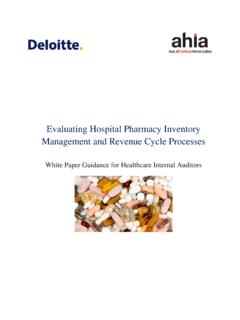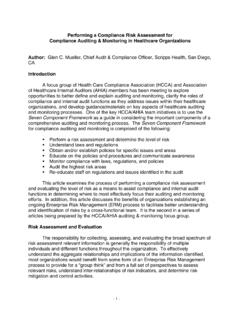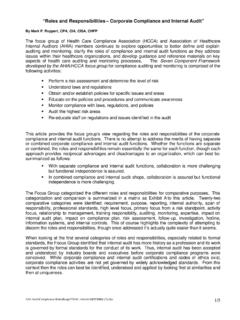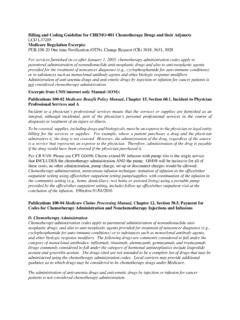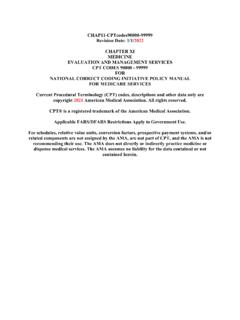Transcription of Documentation, coding, charging, and billing for ...
1 documentation , coding , charging , and billing for medications identifying risks and internal audit focus areas 2 documentation , coding , charging , and billing for medications identifying risks and internal audit focus areas 1 IntroductionMedications administered to patients in both the inpatient and outpatient settings must be properly documented to support the coding and billing requirements for pharmaceutical drugs. The administration of drugs is documented by clinicians in the patient s medication administration record, a component of the patient s permanent medical record. Medical coders and billers abstract the quantity and type of drugs administered from the medical record, assign the appropriate codes, and create a claim to be submitted for reimbursement.
2 Drugs must also be identified and reported using a unique number, called the National Drug Code (NDC), which serves as a universal product identifier for the drugs. The pharmacy is responsible for determining compliance with ordering guidelines, which typically requires that a medication order contain the patient name; age and weight; date and time of the order; drug name; dose, frequency, name of prescriber; and where applicable, the exact strength/concentration, quantity/duration, and other specific instructions for pharmacy department is often an area of focus for financial, compliance, and operations focused internal and external audits given its high dollar spend and impact on patient care.
3 The function is frequently the subject of surveys, site visits and audits by accreditation groups, Centers for Medicare & Medicaid Services (CMS), Office of Inspector General (OIG), Drug Enforcement administration (DEA) or state licensing boards for pharmacy and medicine. 2 Pharmacy charges Patient billling Pharmacy purchasing data Dispensing transactions Charge description master (CDM)Pharmacy revenue cycleThe pharmacy revenue cycle includes the following primary areas: pharmacy purchasing data, dispensing transactions, charge description master (CDM), pharmacy charges, and patient billing . Many organizations may lack the level of vigilance and proper maintenance of the pharmacy revenue cycle that will ensure this process performs effectively.
4 Successful matching of each step of the process ensures that the pharmacy billing and transactions files provide the correct information to the hospital CDM and/or the hospital billing system, and that the correct billing data are submitted to payers on the revenue cycleViolation of the GPO Prohibition (for applicable entity types: DSH, PED, and CAN) documentation , coding , charging , and billing for medications identifying risks and internal audit focus areas 3 Pharmacy purchasing dataSome key risksOne of many risks facing the pharmacy department is the proper documentation and tracking of both used and unused medications. If a drug has been discontinued or was unused, the drug should be returned immediately to the pharmacy and credited to the patient account if charges were generated upon initial distribution.
5 Drug distribution systems and processes should be periodically reviewed, and circumventing distribution controls or the stockpiling of unused drugs should not be allowed. The pharmacy department must be responsible for the procurement, distribution, and control of all drugs used within the organization. The use of night cabinets, drug carts, and other methods discourages the need for non-pharmacy personnel to enter the pharmacy; however, access controls over these solutions must be evaluated to ensure that only those individuals who need access actually have access. Another significant risk is missed pharmacy charges. In order to identify missing drugs, the pharmacy should reconcile the total drugs administered to the patient against the total drugs billed.
6 Charge variances should be promptly investigated to determine the root cause of the discrepancy. Ongoing education should be conducted by the pharmacy and the billing departments to discuss reconciliation errors with staff, as well as identify the causes of their errors and methods to prevent pharmacy department must be responsible for the procurement, distribution, and control of all drugs used within the organization. 4 Some key questions to considerTo comply with coding , billing and documentation requirements, pharmacy management should proactively consider and address several key questions regarding their operations: How is the medication administered to patients documented?
7 Does the documentation include key elements such as the quantity, administration date, administration intervals, start and stop times, and prescriber information? What is the process for charging patient accounts? a. Are patient accounts automatically billed when drugs are dispensed or upon administration ? b. Do charges need to be manually entered into patient accounts based on the medication administration Record (MAR)?c. What types of adjustments can be made to the charges?d. If compounding is completed, how are compounded drugs documented and charged? How are unused medications returned or disposed/wasted, documented, and credited to the patient account and inventory?
8 How is waste documented and billed in certain situations? How are variances identified between medications purchased and medications billed? Is the CDM reviewed on a periodic basis and can it be modified only by appropriate personnel? How is pharmaceutical pricing determined? Is pricing information accurate? How is the NDC to HCPCS billing unit conversion factor configured? What is the pricing methodology for specialty drugs? documentation , coding , charging , and billing for medications identifying risks and internal audit focus areas 5 Conducting a pharmacy revenue cycle internal audit is critical given the multi-disciplinary responsibilities spanning from pharmacists, pharmacy buyers, coding , billing , to patient financial services.
9 Considerations when conducting an internal auditThe following are some example activities to consider when conducting an internal audit: Compare a sample of orders with patient charges and a sample of patient charges with orders, and determine root cause for any differences. Review the override report for drug distribution systems to determine if departments or users are circumventing controls. Assess whether management is performing an active, timely review of overrides. Confirm that discrepancies noted during the review are formally documented and investigated. Determine if a process exists to discard or return unused medications. Assess whether the pharmacy is reconciling unused medications and applying a credit to the patient account.
10 Test to confirm that medications must first be approved by the pharmacy prior to distribution. Review a sample of medications administered to confirm that they are supported by a medication order. Assess whether the order is compliant with ordering guidelines. Determine if a review is performed to identify medication dispensed from the drug distribution system that has not been assigned to a patient. Assess whether a process is in place to charge the medication administered to a patient account for billing . Assess whether interfaces between pharmacy and billing systems are reviewed for errors and adjustments. Determine if there is an approved override listing to allow for emergency pharmaceutical usage.
